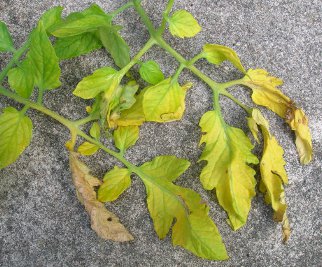The Tomato Race
Two weeks ago I reported that Red Alert was slightly ahead of Stupice and Latah. This week I can report that Stupice and Latah have over-taken Red Alert and both have tomatoes that are turning red. Red Alert has lots of full size toms that have yet to turn colour.
The interesting result about this experiment is that a medium size tall variety (Stupice) has been able to compete with very early cherry size bush varieties.
Why is it important to grow early maturing varieties?
If you are growing tomatoes in a short season area such as the UK, there is a limited time period within which tomatoes can be grown outside.
This means that if you grow late maturing varieties, your toms may still be green when the cold weather sets in and your plants slow down because of the cool autumn weather – fine if you like to make green tomato chutney.
Of course, if you have a greenhouse you aren’t under so much pressure to produce early, so a wider selection of varieties can be grown including the big size – big tasters like Brandywine and Caspian Pink.
The second most popular leaf colour is yellow!
At this time of the season, if you don’t have any yellow leaves around the lower part of your plants, you are doing very well. This is a sign of nitrogen deficiency but it doesn’t mean that your plants are desperate for nitrogen.
Plants send nutrients to their growing tips and ignore the lower leaves, so as long as the new growth look healthy – all is well.
It’s a good idea to remove poorly looking leaves and leaf branches on bush and tall varieties.
The following video contains pinching out, removing side shoots, taking cuttings and more action from the toothbrush.
Pinching out – remove growing tips at four trusses if growing outdoors and six or seven if growing in a greenhouse.
Removing Leaves – remove leaf branches up to the first truss (gradually). As the second truss starts to ripen, remove leaf branches up to the second truss. As the third truss begins to ripen, remove leaf branches up to he third truss.
I’ve never removed leaf branches above the third truss – they look too naked! – so I’ll leave that up to you.
Feeding Tomato Plants
When plants begin to fruit, feed them with tomato food and follow the directions on the packet. That’s all I add to the soil as a root feed.
If you are growing medium or large varieties, be aware that they need calcium to avoid Blossom End Rot – Tomorite does not contain calcium – please check your Tomorite container and tell me if I’m wrong! I hope that they will think about adding calcium to their tomato food soon.
What goes into the soil can do more damage than good. Too much of one nutrient can block another nutrient altogether.
That’s one reason why foliar feeding is so good. It gets into a plant quickly and doesn’t cause a problem down below. For giving extra magnesium and calcium, I highly recommend foliar feeding.
As the season progresses, nutrients can build up in the soil and create a chemical cocktail that would challenge the most experienced bartender!
That’s about it for this week, please leave comments below or send me an email.
Regards,
Nick



anne
Dear Nick, my greenhouse Gardeners Delights look big and strong but the flowers seem weedy , few and far between, and I think they are withering quickly. Also some of the leaved have developed yellowish mottled patches. Any thoughts? thanks Anne
Nick
Hi Anne,
The withering flowers problem is probably Blossom Drop – the flowers fail to pollinate.
See https://www.tomatogrowing.co.uk/good-vibrations
The yellow mottled patches are the result of nutrient deficiency (magnesium) which is very common at this time of the season and nothing to worry about, just keep feeding tomato food.
Regards,
Nick
Derek Richards
Nick..
What happens if I remove the leaves before the tomatos have set?… you know just when the flowers are opened?
Derek
Nick
Hi Derek,
Shouldn’t be a problem below first truss – some varieties are fussier than others.
Regards,
Nick
JOSEPH JAMES
When I was leaving my plants for 5 days I filled the trays they stand in with water,unfortunately one of the plants was in a deep container and I filled it too full.The result was I lost a good plant which was fruiting well, it shows that too much water can be as bad as too little.The plants are in a greenhouse and I thought I’d play safe in case we had some blazing sunshine while I was away. You live and learn.
Nick
Hi Joseph,
Thanks for sharing your story … it is a lesson to us all not to saturate the soil with water or we starve the roots of air and tomato plants can’t cope with waterlogged soil.
Regards,
Nick
Avril
Hi Nick
When removing leaf branches up to the second truss when they start to ripen, is it okay to do this when some of the toms from the first truss are still green or should you wait until all the toms from the first truss are ripe.
Thanks
Nick
Hi Avril,
Yes that’s fine – as soon as the first toms are ready to be picked, you can move and remove upwards!
Regards,
Nick
roy hawker
hi,nick,my legend toms are doing fantastic allso my firline are doing great i am eating my cherry toms
Nick
Hi Roy,
You’ve picked a good couple of varieties just in case we get a lot of rain!
I find that cherry toms are the first to mature but I’ve been very impressed with Stupice this season – I picked the first one yesterday.
Regards,
Nick